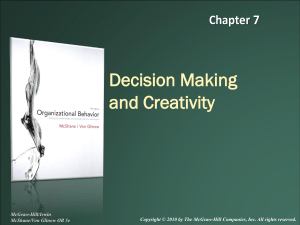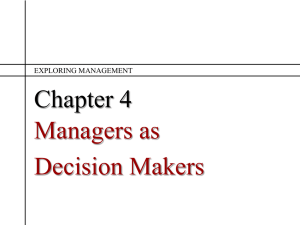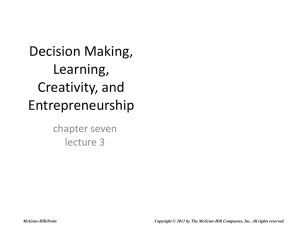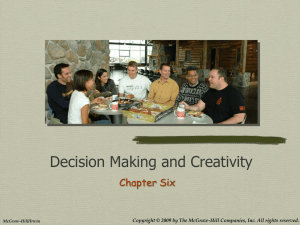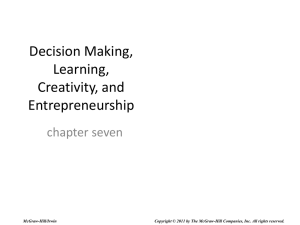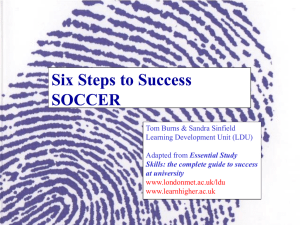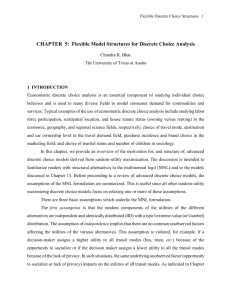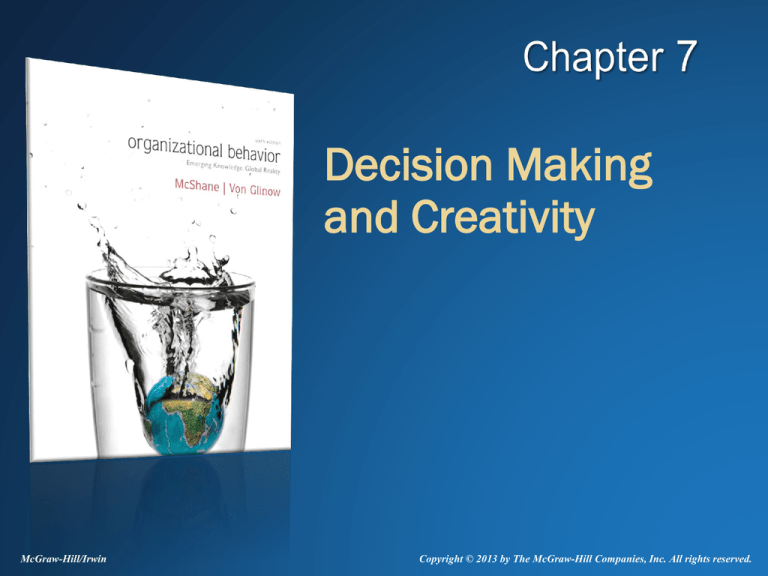
Decision Making
and Creativity
McGraw-Hill/Irwin
Copyright © 2013 by The McGraw-Hill Companies, Inc. All rights reserved.
Decision Making, Creativity, and
Involvement at Chrysler Corp.
Fiat and Chrysler CEO Sergio
Marchionne encourages better
decision making, involvement,
and creativity to revitalize
Chrysler Corp.
7-2
Decision Making Defined
The conscious process of
making choices among one or
more alternatives with the
intention of moving toward
some desired state of affairs.
7-3
Rational Choice Paradigm
Rational choice paradigm -- effective
decision makers identify, select, and apply
the best possible alternative
Two main elements of rational choice
1. Subjective expected utility – determines choice
with highest value (maximization)
2. Decision making process – systematic stages of
decision making
7-4
Rational Choice Decision-making
Process
2. Choose the
best decision
process
Subjective
expected utility
7-5
Problem Identification Challenges
Problems/opportunities are constructed from
ambiguous information, not “given” to us
Influenced by cognitive and emotional biases
Five problem identification challenges
• Stakeholder framing
• Mental models
• Decisive leadership
• Solution-focused problems
• Perceptual defense
7-6
Identifying Problems Effectively
1.
Be aware of perceptual and diagnostic limitations
2.
Fight against pressure to look decisive
3.
Maintain “divine discontent” (aversion to
complacency)
4.
Discuss the situation with colleagues -- see different
perspectives
7-7
Making Choices: Rational vs OB
Observations
Rational Choice
Paradigm Assumptions
Observations from
Organizational Behavior
Goals are clear, compatible, and
agreed upon
Goals are ambiguous,
conflicting, and lack agreement
People are able to calculate all
alternatives and their outcomes
People have limited information
processing abilities
People evaluate all alternatives
simultaneously
People evaluate alternatives
sequentially
more
7-8
Making Choices: Rational vs OB
Observations (con’t)
Rational Choice
Paradigm Assumptions
Observations from
Organizational Behavior
People use absolute standards
to evaluate alternatives
People evaluate alternatives
against an implicit favorite
People make choices using
factual information
People make choices using
perceptually distorted information
People choose the alternative
with the highest payoff (SEU)
People choose the alternative
that is good enough (satisfice)
7-9
Biased Decision Heuristics
People have built-in decision heuristics that bias
evaluation of alternatives
1. Anchoring and adjustment – initial information (e.g., opening
bid) influences evaluation of subsequent information
2. Availability heuristic – we estimate probabilities by how easy
we can recall the event, even though other factors influence
ease of recall
3. Representativeness heuristic -- we estimate probabilities by
how much they are similar to something else (e.g.
stereotypes) even when better info about probabilities is
available
7-10
Paralyzed by Choice
Decision makers are less likely
to make any decision at all as
the number of options
increases
Occurs even when there are
clear benefits of selecting any
alternative (such as joining a
company pension plan).
Evidence of human information
processing limitations
Courtesy of Microsoft
7-11
Emotions and Making Choices
1.
Emotions form preferences before we
consciously evaluate those choices
2.
Moods and emotions influence how well we
follow the decision process
3.
We ‘listen in’ on our emotions and use that
information to make choices
7-12
Intuitive Decision Making
Ability to know when a problem or
opportunity exists and select the best course
of action without conscious reasoning
Intuition as emotional experience
• Gut feelings are emotional signals
• Not all emotional signals are intuition
Intuition as rapid nonconscious analysis
• Uses action scripts
7-13
Making Choices more Effectively
Systematically evaluate alternatives against
relevant factors
Be aware of effects of emotions on decision
preferences and evaluation process
Scenario planning
7-14
Problems with Decision
Evaluation
Confirmation bias
• Inflate quality of the selected option; forget or
downplay rejected alternatives
• Caused by need to maintain a positive selfconcept
Escalation of commitment
• Repeating or further investing in an apparently bad
decision
• Caused by self-justification, prospect theory effect,
perceptual blinders, closing costs
7-15
Evaluating Decisions More
Effectively
Separate decision choosers from evaluators
Establish a preset level to abandon the
project
Find sources of systematic and clear
feedback
Involve several people in the evaluation
process
7-16
Tangible Creativity
Alex Beim, founder and chief
creative technologist of Tangible
Interaction Design in Vancouver,
relies on creative thinking to invent
enticing interactive displays, such as
the zygotes at the Vancouver
Olympics.
7-17
Creativity Defined
Developing an original idea that
makes a socially recognized
contribution
Applies to all aspects of the
decision process – problems,
alternatives, solutions
7-18
Creative Process Model
Verification
Illumination
Incubation
Preparation
7-19
Characteristics of Creative People
Independent imagination
includes:
• Higher openness to
experience personality
• Lower need for affiliation
motivation
• Higher selfdirection/stimulation values
Independent
imagination
Cognitive and
practical
intelligence
Characteristics
of Creative
People
Subject
knowledge/expe
rience
Persistence
7-20
Creative Work Environments
Learning orientation
• Encourage experimentation
• Tolerate mistakes
Intrinsically motivating work
• Task significance, autonomy, feedback
Open communication and sufficient
resources
Unclear/complex effects of team competition
and time pressure on creativity
7-21
Creative Activities
Redefine
the Problem
Associative
Play
CrossPollination
• Review
abandoned
projects
• Storytelling
• Diverse teams
• Artistic activities
• Explore issue
with other
people
• Morphological
analysis
• Information
sessions
• Internal
tradeshows
7-22
Employee Involvement at Yabulu
Employee involvement was a
key factor in skyrocketing
productivity at the Yabulu
nickel and cobalt refinery in
northern Queensland,
Australia. “We have given
power to the people, and it is
working,” says refinery
general manager Trefor Flood
(in photo).
7-23
Employee Involvement Defined
•
The degree to which
employees influence how
their work is organized and
carried out
•
Various levels and forms of
involvement
7-24
Employee Involvement Model
Potential Involvement
Outcomes
• Better problem
identification
Employee
Involvement
• Synergy produces
more/better solutions
Contingencies
of Involvement
• Better at selecting
the best choice
• Higher decision
commitment
7-25
Contingencies of Involvement
Higher employee involvement is better when:
Decision
Structure
Knowledge
Source
Decision
Commitment
Risk of
Conflict
• Problem is new & complex
(i.e nonprogrammed decision)
• Employees have relevant knowledge
beyond leader
• Employees would lack commitment
unless involved
1. Norms support firm’s goals
2. Employee agreement likely
7-26
Decision Making
and Creativity
The following exhibit on
subjective expected
utility (SEU) is not
presented in the book
Subjective Expected Utility
Estimating the best possible
alternative (maximization)
Expected -- probability of an
outcome occurring
.2
Choice A
Choice ‘B’ has higher utility (value)
than choice ‘A’
Choice ‘B’ expected utility is
(.8x7)+(.2x-2)+(.3x1)=6.4
Outcome 2 (-2)
.9
e.g., Chance that outcome 3 will
occur is 90% if choice ‘A’ is chosen,
30% if choice ‘B’ is chosen
Utility -- Value or happiness
produced by each option from
value of expected outcomes
.5
Outcome 1 (+7)
Outcome 3 (+1)
.8
Choice B
.2
Outcome 1 (+7)
Outcome 2 (-2)
.3
Outcome 3 (+1)
Probability of
outcome occurring
Utility (expected
happiness)
7-28
Solutions to
Creativity
Brainbusters
Double Circle Problem
7-30
Nine Dot Problem
7-31
Nine Dot Problem Revisited
7-32
Word Search
FCIRVEEALTETITVEERS
7-33
Burning Ropes
After first rope burned
i.e. 30 min.
One Hour to Burn Completely
7-34

